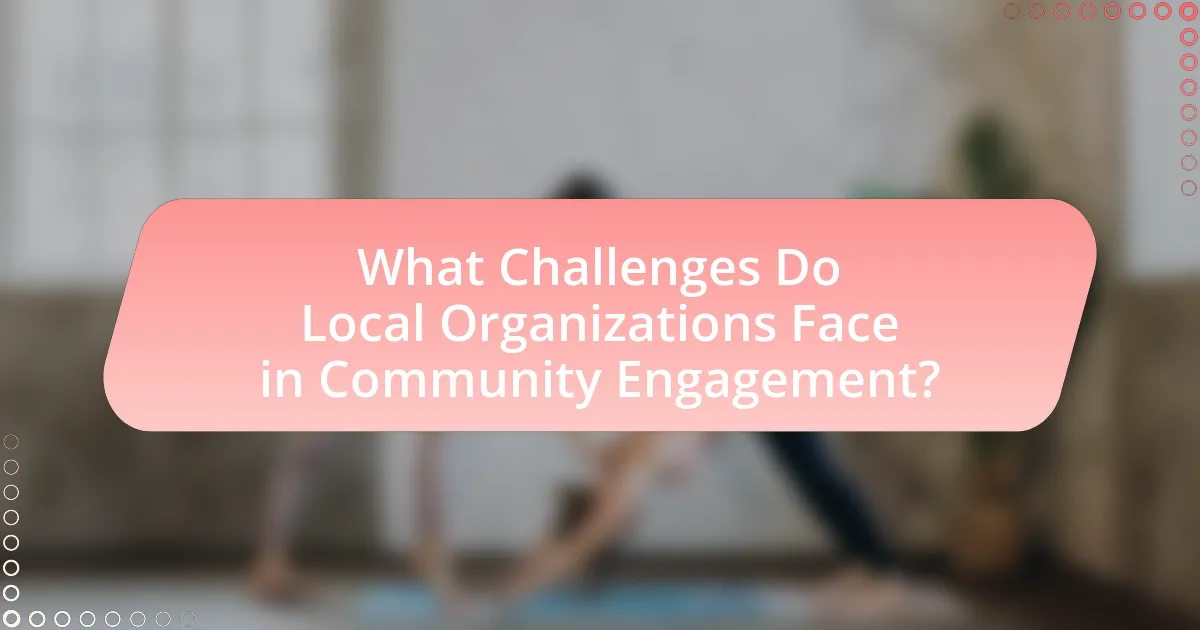The article explores the significant role of community in fostering connection, support, and collective action, emphasizing how local organizations enhance community engagement and development. It outlines key elements of community engagement, such as participation and collaboration, and discusses the benefits of strong community ties for organizations, including increased trust and resource sharing. Additionally, the article addresses challenges faced by local organizations in engaging communities and presents strategies for overcoming these barriers, measuring impact, and enhancing community support through effective communication and innovative approaches. Overall, it highlights the symbiotic relationship between local organizations and communities, underscoring the importance of collaboration for sustainable development and improved quality of life.

What is the Power of Community?
The power of community lies in its ability to foster connection, support, and collective action among individuals. Communities provide a network that enhances social cohesion, enabling members to share resources, knowledge, and emotional support. Research indicates that strong community ties can lead to improved mental health outcomes, as individuals feel a sense of belonging and purpose. For instance, a study published in the American Journal of Public Health found that social support from community networks significantly reduces stress and promotes well-being. Thus, the power of community is evident in its capacity to create resilient, supportive environments that enhance the quality of life for individuals and groups.
How does community engagement influence local organizations?
Community engagement significantly enhances local organizations by fostering stronger relationships and increasing resource accessibility. Engaged communities often provide valuable feedback, which helps organizations tailor their services to better meet local needs. For instance, a study by the National Council of Nonprofits found that organizations with active community involvement reported a 30% increase in volunteer participation and a 25% increase in donations. This demonstrates that when local organizations prioritize community engagement, they not only improve their operational effectiveness but also build trust and loyalty among community members.
What are the key elements that define community engagement?
The key elements that define community engagement include participation, collaboration, communication, and empowerment. Participation involves active involvement of community members in decision-making processes, ensuring their voices are heard and valued. Collaboration refers to partnerships between local organizations, residents, and stakeholders to address community needs collectively. Effective communication is essential for sharing information, fostering trust, and building relationships within the community. Empowerment focuses on equipping individuals with the skills and resources necessary to take action and influence change in their environment. These elements are supported by research indicating that communities with high levels of engagement experience improved social cohesion and better outcomes in public health and education.
How do local organizations foster community engagement?
Local organizations foster community engagement by creating opportunities for participation and collaboration among residents. They achieve this through organizing events, such as community clean-ups, workshops, and social gatherings, which encourage residents to connect and contribute to local initiatives. For example, a study by the National Civic League found that communities with active local organizations report higher levels of civic participation and social cohesion. By providing resources, support, and a platform for voices to be heard, local organizations effectively mobilize community members and strengthen the social fabric of the area.
Why is community support vital for local organizations?
Community support is vital for local organizations because it enhances their sustainability and effectiveness. Local organizations rely on community engagement for resources, volunteer support, and financial contributions, which are essential for their operations. For instance, a study by the National Council of Nonprofits indicates that organizations with strong community ties experience higher levels of funding and volunteerism, leading to improved service delivery and community impact. This symbiotic relationship fosters a sense of belonging and shared purpose, ultimately strengthening the community as a whole.
What are the benefits of strong community ties for organizations?
Strong community ties provide organizations with enhanced support, increased trust, and improved collaboration. These benefits lead to greater resource sharing, which can result in cost savings and innovation. For instance, organizations with strong community connections often experience higher employee morale and retention rates, as employees feel more engaged and valued within a supportive environment. Additionally, research from the Stanford Social Innovation Review indicates that organizations embedded in their communities can leverage local networks for fundraising and volunteer support, ultimately driving mission success.
How does community support enhance organizational sustainability?
Community support enhances organizational sustainability by fostering strong relationships that lead to increased resources, loyalty, and collaboration. When organizations engage with their local communities, they often receive financial backing, volunteer efforts, and in-kind donations, which can significantly reduce operational costs and enhance service delivery. For instance, a study by the Stanford Social Innovation Review found that organizations with strong community ties are 50% more likely to achieve long-term sustainability due to the trust and goodwill built within the community. This trust translates into customer loyalty, which is crucial for maintaining revenue streams and ensuring ongoing support. Additionally, community involvement can lead to innovative partnerships that drive new initiatives and improve overall organizational resilience.

How do Local Organizations Contribute to Community Development?
Local organizations contribute to community development by addressing specific needs and fostering collaboration among residents. They provide essential services such as education, healthcare, and job training, which directly enhance the quality of life. For instance, according to a report by the National Council of Nonprofits, local organizations create jobs and stimulate economic growth by supporting small businesses and local entrepreneurs. Additionally, they engage community members in decision-making processes, ensuring that development initiatives reflect the community’s priorities and values. This participatory approach not only empowers residents but also strengthens social cohesion, leading to more sustainable development outcomes.
What roles do local organizations play in community building?
Local organizations play a crucial role in community building by fostering social connections, providing resources, and facilitating civic engagement. These organizations create networks that connect individuals, enhancing social cohesion and trust within the community. For instance, studies show that neighborhoods with active local organizations experience higher levels of participation in community events and initiatives, which leads to improved community well-being. Additionally, local organizations often offer programs and services that address specific community needs, such as education, health, and economic development, thereby empowering residents and promoting collective action.
How do local organizations address community needs?
Local organizations address community needs by identifying specific issues and mobilizing resources to provide targeted support. They conduct assessments to understand the unique challenges faced by their communities, such as food insecurity, lack of education, or health disparities. For example, food banks distribute meals to low-income families, while educational nonprofits offer tutoring and mentorship programs. Research shows that community-based organizations improve local well-being by fostering collaboration among residents and stakeholders, leading to sustainable solutions that directly impact quality of life.
What initiatives do local organizations implement for community improvement?
Local organizations implement various initiatives for community improvement, including food banks, educational programs, and environmental clean-up efforts. Food banks address hunger by providing essential resources to low-income families, with organizations like Feeding America serving over 40 million people annually. Educational programs, such as after-school tutoring and vocational training, enhance skills and opportunities for community members, contributing to workforce development. Environmental clean-up initiatives, often organized by local nonprofits, mobilize volunteers to restore parks and public spaces, fostering community pride and sustainability. These initiatives collectively strengthen community ties and improve the overall quality of life.
How can local organizations mobilize community resources?
Local organizations can mobilize community resources by establishing partnerships with stakeholders, engaging community members, and leveraging existing assets. By collaborating with local businesses, government agencies, and non-profits, organizations can pool resources and expertise to address community needs effectively. For instance, a study by the National Council of Nonprofits highlights that organizations that actively involve community members in decision-making processes are more successful in mobilizing resources, as they foster a sense of ownership and commitment among residents. Additionally, utilizing local assets, such as volunteers and facilities, allows organizations to maximize their impact without incurring significant costs.
What strategies do organizations use to engage volunteers?
Organizations engage volunteers through strategies such as effective communication, recognition programs, and providing meaningful opportunities. Effective communication involves clearly outlining the organization’s mission and volunteer roles, which fosters a sense of belonging and purpose among volunteers. Recognition programs, such as awards or public acknowledgments, enhance volunteer motivation and retention by making volunteers feel valued. Additionally, offering meaningful opportunities that align with volunteers’ skills and interests increases engagement, as studies show that volunteers are more likely to commit when they find the work personally fulfilling.
How do local organizations collaborate with other community entities?
Local organizations collaborate with other community entities through partnerships, resource sharing, and joint initiatives. These collaborations often involve pooling resources to address community needs, such as organizing events, providing services, or tackling social issues. For instance, a local nonprofit may partner with schools and businesses to create educational programs, thereby enhancing community engagement and support. Research shows that such collaborations can lead to improved outcomes, as evidenced by a study from the Stanford Social Innovation Review, which highlights that collective impact initiatives can significantly increase the effectiveness of community programs.

What Challenges Do Local Organizations Face in Community Engagement?
Local organizations face several challenges in community engagement, including limited resources, lack of awareness, and difficulties in building trust. Limited resources, such as funding and personnel, hinder their ability to effectively reach and engage community members. A study by the National Council of Nonprofits indicates that 70% of local organizations report insufficient funding as a barrier to engagement efforts. Additionally, lack of awareness about the organization’s mission and activities can prevent community members from participating. Finally, building trust within diverse communities is often challenging, as historical mistrust can lead to skepticism about the organization’s intentions and effectiveness.
What are common barriers to effective community involvement?
Common barriers to effective community involvement include lack of awareness, limited resources, and insufficient communication. Lack of awareness prevents individuals from understanding available opportunities for participation, as many community members may not be informed about local initiatives or organizations. Limited resources, such as time, funding, and manpower, hinder the ability of both individuals and organizations to engage effectively in community activities. Insufficient communication between community leaders and residents can lead to misunderstandings and disengagement, as residents may feel their voices are not heard or valued. These barriers collectively impede the potential for meaningful community involvement and collaboration.
How can local organizations overcome these barriers?
Local organizations can overcome barriers by fostering collaboration among community members and stakeholders. By creating partnerships with local businesses, government agencies, and other nonprofits, organizations can pool resources, share knowledge, and enhance their collective impact. For instance, a study by the National Council of Nonprofits highlights that collaborative efforts can lead to increased funding opportunities and improved service delivery, demonstrating that working together can effectively address challenges faced by individual organizations.
What role does funding play in community engagement challenges?
Funding is crucial in addressing community engagement challenges as it directly influences the resources available for outreach, programming, and capacity building. Adequate funding allows organizations to implement effective engagement strategies, hire skilled personnel, and develop necessary materials that resonate with community members. For instance, a study by the National Endowment for the Arts found that communities with higher funding levels for arts and culture initiatives experienced increased participation and engagement, demonstrating the link between financial support and active community involvement. Thus, insufficient funding can lead to limited outreach efforts, reduced program quality, and ultimately hinder community participation.
How can local organizations measure their impact on the community?
Local organizations can measure their impact on the community through quantitative and qualitative assessments, including surveys, community feedback, and performance metrics. For instance, organizations can distribute surveys to community members to gather data on satisfaction and perceived changes resulting from their initiatives. Additionally, tracking specific metrics such as the number of individuals served, resources distributed, or programs implemented provides concrete evidence of impact. A study by the Stanford Social Innovation Review highlights that organizations employing mixed-method evaluations, combining both qualitative narratives and quantitative data, achieve a more comprehensive understanding of their community impact.
What metrics are used to assess community engagement success?
Metrics used to assess community engagement success include participation rates, feedback surveys, social media interactions, and event attendance. Participation rates measure the number of individuals involved in community activities, indicating overall interest and involvement. Feedback surveys provide qualitative data on community members’ perceptions and satisfaction, helping organizations understand their impact. Social media interactions, such as likes, shares, and comments, reflect the online engagement level and community sentiment. Event attendance quantifies the number of participants in organized activities, serving as a direct indicator of community interest and engagement. These metrics collectively offer a comprehensive view of community engagement effectiveness.
How can feedback from the community improve organizational efforts?
Feedback from the community can significantly enhance organizational efforts by providing insights that align initiatives with community needs. When organizations actively solicit and incorporate community feedback, they can identify gaps in services, improve program effectiveness, and foster greater trust and engagement among stakeholders. For instance, a study by the Stanford Social Innovation Review found that organizations that engage with their communities are 50% more likely to achieve their goals, as they can adapt their strategies based on real-time input and experiences from community members. This iterative process not only leads to more relevant and impactful programs but also strengthens the relationship between the organization and the community it serves.
What are best practices for local organizations to enhance community support?
Local organizations can enhance community support by actively engaging with residents through regular communication and collaboration. Establishing open channels for feedback, such as community meetings or surveys, allows organizations to understand the needs and concerns of the community. Research shows that organizations that involve community members in decision-making processes foster a sense of ownership and commitment, leading to increased support. For instance, a study by the National Civic League found that communities with strong civic engagement initiatives report higher levels of trust and cooperation among residents. Additionally, partnering with local businesses and schools can amplify resources and outreach efforts, creating a more robust support network.
How can organizations effectively communicate with their community?
Organizations can effectively communicate with their community by utilizing multiple channels such as social media, newsletters, community meetings, and local events. These methods allow organizations to disseminate information, gather feedback, and foster engagement. For instance, a study by the Pew Research Center found that 69% of adults in the U.S. use social media, making it a vital platform for reaching diverse community members. Additionally, hosting regular community meetings can create a space for dialogue, ensuring that the voices of community members are heard and considered in decision-making processes. This multi-channel approach not only enhances transparency but also builds trust between organizations and their communities.
What innovative approaches can organizations adopt to strengthen community ties?
Organizations can adopt innovative approaches such as collaborative community projects, digital engagement platforms, and local partnerships to strengthen community ties. Collaborative community projects, like neighborhood clean-ups or community gardens, foster teamwork and a sense of ownership among residents. Digital engagement platforms, such as social media groups or community apps, facilitate communication and information sharing, enhancing connectivity. Local partnerships with schools, businesses, and nonprofits can create resource-sharing opportunities and joint events, further embedding organizations within the community fabric. These strategies have been shown to increase community participation and cohesion, as evidenced by studies indicating that engaged communities experience higher levels of trust and social capital.


